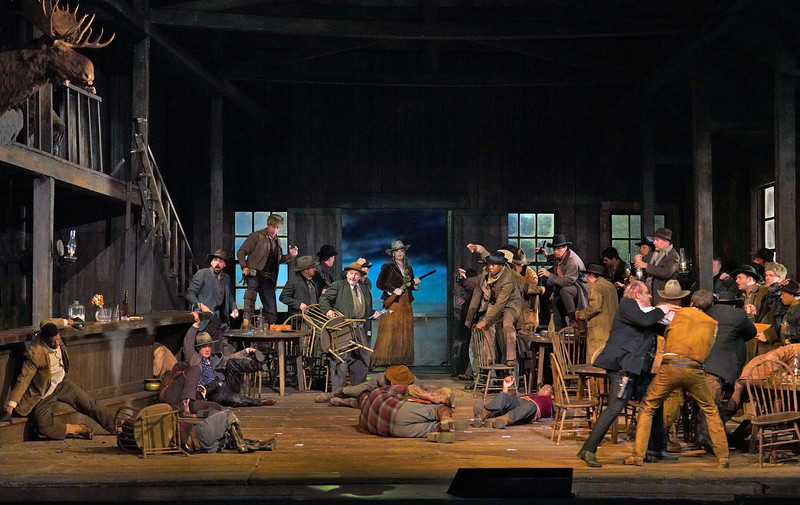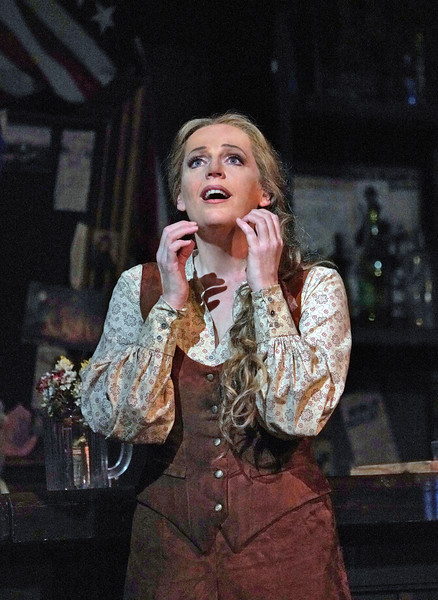Puccini’s La Fanciulla del West strikes gold at the Met
Puccini’s La Fanciulla del West is a special opera in my long canon of hits, but this is about 2018, not about those performances in my past. You go Girl!
La Fanciulla del West was, one guesses, revived due to the availability of tenor Jonas Kaufmann, who has not appeared at the Met for a few years, and his stage match mate, soprano Eva-Maria Westbroek, who appeared with him here previously in Die Walküre (2011), unforgettable performance, this, and on DVD in a Royal Opera House, Covent Garden production of Andrea Chenier. That there is already chemistry between them adds to the impact of the drama about to unfold in your performance.
A simple explanation for why La Fanciulla del West is, relatively speaking, a neglected child in Puccini’s family of operas could be because Nessun dorma is in Turandot, Un bel di is in Madama Butterfly, and so on, but save Ch’ella mi creda libero e lontano, Dick Johnson’s brief solo in Act III, there are no other arias or duets that have managed to make their ways out of the house for recital discs. And also, mainly our issue this side of the Atlantic, an opera sung in Italian about miners, sheriffs, and bandits in the wild west of the California Gold Rush is a bit of a stretch. Whisky per tutti! indeed.*
The Polka Saloon’s regulars decompose when Minnie is away
The cast of miners, sheriffs, and postal workers is large, which, in addition to calling for big choral moments, creates a significant challenge for character definition and interpersonal and musical coordination. Puccini creates several vignettes to show, rather than talk about, their various relationships with Minnie and with each other. Each must be realized both vocally and dramatically.
In Act I, which is on the long side, we find Minnie as the men’s caretaker, surrogate mother, religious educator, and sometimes it’s her turn to watch over their gold hidden under the bar, which, as it happens, falls on the night when the bandit Ramerrez and his gang have come to steal it. Life is really tough and lonely there in the wilderness. They need her comfort, counseling, and support. In sum, Minnie is the guardian angel here and the boys are quick to anger when someone, like an arrogant Sheriff Jack Rance or the stranger “Dick Johnson” threatens these relationships.
Eva-Maria Westbroek is Minnie
Turns out that “Dick Johnson,” Ramerrez in disguise, had met Minnie before on the trail to Monterey, an encounter of mutual attraction, concluding, innocently enough, just with promises not to forget each other. One wonders if he was drawn back into Minnie’s world by a higher power for his own salvation. And for hers. The themes of redemption and salvation weave themselves throughout the story. Minnie is referred to as an angel.**
Eva-Maria Westbroek is a complex Minnie, both tough and tender, buttoned up and self-protecting, but underneath needy of a deeper, more soulful, more permanent relationship. Minnie remembers the love and happiness of her parents, and though ‘mothering’ the miners to some degree fills an emotional void, it is not the same. Frequent references to one Nina Micheltorena,*** a loose woman nearby who makes a living off the miners, provide us with clues of what sort of relationship Minnie most certainly will not find acceptable. Thus one feels the tension in Act II mount as Minnie prepares to lower her guard with Johnson, whom she invites to her abode for a goodbye. Westbroek meets the considerable vocal challenges without difficulty after her brief stretch of warming up. Brava!
Jonas Kaufmann as Dick Johnson at Minnie’s home in Act II
The chemistry between her and tenor Jonas Kaufmann is evident throughout. His performance style tends toward interpersonal intensity, thereby creating a context for an equally intense response from his women. Watch their body language. Though we were informed of his suffering from a cold, vocally Kaufmann is in relatively fine shape, though not quite so cavalier and free with his upper range as in the past. But he remains a presence in every scene, even when wounded and bleeding from the rafters or about to be hanged in the cold dawn.
Sheriff Jack Rance, a tough man also in search of a deeper human connection, is sung by Željko Lučić. His stiffness, his cruel and gruff manner, not to mention the fact that he’s already married, put him out of the running for Minnie’s hand, but also spell trouble for anyone who seems to get closer to her.
Željko Lučić and the boys prepare to capture Dick Johnson in Act III
The large cast includes some standout performances: Carlo Bosi is Nick, Michael Todd Simpson is Sonora, Scott Scully is Joe, Richard Bernstein is Bello, and Joseph Barron is Happy. Alok Kumar is Harry, Matthew Rose is Mr. Ashby of Wells-Fargo, Ian Koziara is a Pony Express Rider, Oren Gradus is Jake Wallace, Jeongcheol Cha is Sid, Adrian Timpau is Jim Larkens, Eduardo Valdes is Trin, and Kidon Choi is José Castro. MaryAnn McCormick is Wowkle and Philip Cokorinos is Billy Jackrabbit. Big cast, neatly differentiated.
Marco Armiliato brings out the riches of Puccini’s elaborate score, which, in Act II, looking backward, recalls the intensity of Act II of Tosca and, looking forward, anticipates the big complexity and richness of Turandot, these two lying more or less a decade in Puccini’s past and future. It is a rewarding experience on every level. Donald Palumbo coordinates the soloists and members Metropolitan Opera Chorus. Big, like California!
The production, originally conceived by Giancarlo del Monaco, son of the great Mario del Monaco, premiered in 1991. It is realized this season by director Gregory Keller, with the wonderfully wild western sets by Michael Scott, lighting by Gil Wechsler. The scenery fills the stage in each act and each set contains at least two levels, either balconies or attic space; enhancing the action are horses, wagons, gunshots, and snow to rival Paris in winter in La Bohème.
It is hard to believe that La Fanciulla del West, which had its world premiere at the Met on December 10, 1910, has racked up only 109 performances over the Company’s long history. Saturday, the last, is 111. Don’t miss it. You never know when the Met will perform it again.
Reviewed performance date: October 20, 2018.
Photos: Ken Howard.
*But then let’s be real here: every opera is a big stretch if you’re looking for the exercise. ALL operas, all forms of art are not real. But to a receptive audience, operas can be powerful experiences, as most of us know well. For the record, Aïda is sung in Italian too, not in ancient Egyptian.
**Though like Clarence in It’s a Wonderful Life, Minnie must earn her wings.
***Nina never actually appears on stage.
La Fanciulla del West is performed in three acts with two rather long intermissions, probably due to the complexity of assembling the sets, judging from the hammering backstage. The running time of the HD performance is about three and three quarter hours.
Enjoy! A totally beautiful night in wonderful company. Plus October is a beautiful month. Heaven!
OM



